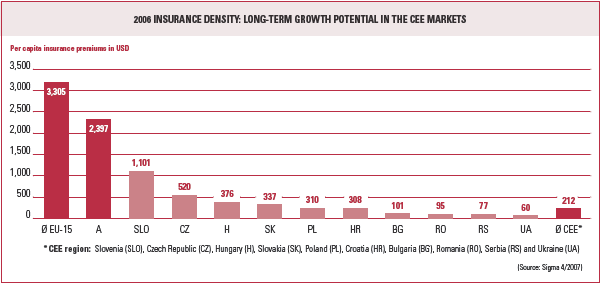Different stages of development also exist among insurance markets within the CEE region, which can be summarised in terms of two growth areas:
- According to Swiss Re, the insurance densities of USD 520 in the Czech Republic, USD 376 in Hungary, USD 337 in Slovakia, USD 310 in Poland and USD 308 in Croatia are considerably higher than the average insurance density of USD 212 for the CEE region. Due to the great increase in the living standard of the approximately 70 million people living in these markets, life insurance is the main area of above-average growth. As a result, the share of life insurance premiums reaches mostly 30% of total premium volume in these insurance markets. In addition, current or imminent reforms to government pension systems are strengthening the trend toward private pensions.
Motor vehicle insurance is the most important business of non-life insurance in this region, although property insurance is also gaining in importance in the household and homeowners’ insurance areas due to increasing prosperity. Strong positions in both the life and non-life insurance markets in the Czech Republic, Slovakia, Poland and Croatia put the Vienna Insurance Group in an optimal position to participate in this growth.
- According to Swiss Re, the insurance densities of USD 101 in Bulgaria, USD 95 in Romania, USD 77 in Serbia and USD 60 in Ukraine are lower than the values for the CEE countries mentioned above. As a result, the catch-up potential is still greater here than in the CEE markets mentioned previously. This is shown clearly by annual growth rates of 20–30% in premium volume, with non-life insurance still representing a large percentage of total premium volume.
Due to the lower standard of living in these countries, the life insurance market is less developed, and represents only between 3% to 20% of total premium volume in these insurance markets. This means, however, that the growth potential in these countries is all the higher. The Vienna Insurance Group ensures that it would have an opportunity to participate in the economic growth in Bulgaria, Romania, Serbia and Ukraine, which have a total population of approximately 83 million, by expanding its leading positions through acquisitions and organic growth in these markets in 2007.


